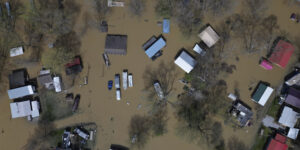New York state officials plan to sue the U.S. Environmental Protection Agency for allowing General Electric Co to stop clearing the Hudson River of PCB contamination before the cleanup work was finished.
Governor Andrew Cuomo and Attorney General Letitia James announced the planned lawsuit on Thursday, after the EPA issued a “certificate of completion” permitting GE to stop dredging until further studies showed whether it had done enough cleanup.
“Time and again the Trump administration puts corporations and polluters’ interests ahead of public health and the environment,” Cuomo said.
“Since the EPA has failed to hold GE accountable for fulfilling its obligation to restore the river, New York State will take any action necessary to protect our waterways,” he added.
New York is one of many Democratic-leaning states that often sue over White House efforts to ease regulatory oversight of businesses.
In interviews on Thursday, EPA officials said they lacked enough data to require more dredging by Boston-based GE under its 2006 consent decree.
“This certification does not let GE off the hook,” said Regional Administrator Peter Lopez, a former six-term Republican state assemblyman. “If the data shows we’re not heading in the right direction, we have the ability to compel more work, which could mean more dredging.”
Lopez’s deputy Walter Mugdan, a 43-year EPA veteran, added: “This is not a political decision. It is being driven by the science and the law.”
GE said the EPA decision confirmed it had “successfully completed the Hudson River dredging project,” and pledged to collect more environmental data to assess river conditions.
PCBs, or polychlorinated biphenyls, were used in electrical equipment, carbonless copy paper and other products before a 1979 U.S. manufacturing ban, and are considered possible human carcinogens. (https://www.epa.gov/pcbs/learn-about-polychlorinated-biphenyls-pcbs)
GE dumped roughly 1.3 million pounds of PCBs from two since-closed capacitor manufacturing plants, located north of the state capital of Albany, into the Hudson River from 1947 to 1977.
While most pollution occurred nearby in a 40-mile (64 km) zone, about 200 miles of the river was polluted, stretching as far south as Battery Park in Manhattan.
GE has spent an estimated $1.7 billion over eight years on cleanup, including six years of dredging.
But state officials called GE’s work “incomplete,” and said the EPA decision could make it harder to later require more dredging or other remedial measures.
In a December study, the state’s Department of Environmental Conservation found PCB levels in fish in the upper Hudson after dredging essentially the same as before.
State officials said PCB levels remain above even what the EPA considers safe.





















 Progressive: Policies Grow Faster Than Workforce
Progressive: Policies Grow Faster Than Workforce  Allstate: How Can You Save on Auto Insurance?
Allstate: How Can You Save on Auto Insurance?  Insurance Industry Contemplates Knock-On Effect of Tariffs to Claims, Consumers
Insurance Industry Contemplates Knock-On Effect of Tariffs to Claims, Consumers  Revisiting California’s Wildfires: A Personal Journey
Revisiting California’s Wildfires: A Personal Journey 




